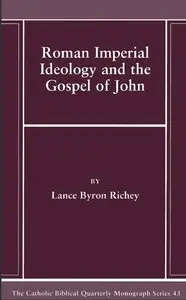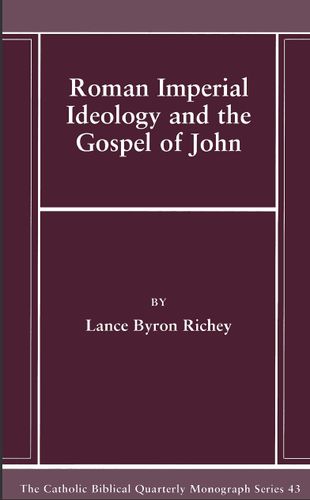Roman Imperial Ideology and the Gospel of John By Lance Byron Richey
Publisher: Catholic Biblical Association of America 2007 | 228 Pages | ISBN: 0915170434 | PDF | 4 MB
Publisher: Catholic Biblical Association of America 2007 | 228 Pages | ISBN: 0915170434 | PDF | 4 MB
This book was originally the author’s dissertation directed by Dr. Julian Hills at Marquette University and completed in 2004. The introduction suggests the work’s thesis, that John’s Gospel is “a conscious effort on the part of John to address issues which would unavoidably have been raised for his community by the Roman Imperial Ideology, or, as it is more commonly called, Augustan Ideology” (xii). This “complex and considerably varied set of beliefs, practices and claims about the nature and source of temporal power in imperial Rome … presented the emperor or princeps as the central figure of the empire on whom [its] continued peace and prosperity … depended” (xiv). The pervasiveness of this ideology, more than the demands of the imperial cult, meant a “pressing need to distinguish the nature and role of the emperor within Roman society from that of Christ within the Johannine community” (xvi). The Gospel, at least in its final redaction, challenges the “fundamental way of conceiving the world” that imperial ideology offered (xix). Chapter 1 (“Neither Jew nor Roman: Reconstructing the History of the Johannine Community,”) largely rehearses previous work on John that has emphasized the Gospel’s multilayered nature and has sought to reconstruct the history of the Johannine community (so Martyn and Brown). This history conventionally involves a developing Christology, separation from a synagogue precipitated by the Birkat Haminim, persecution and martyrdom, Gentile influx, further christological development, schism, and alienation. From this survey, Richey identifies three key features: Asia Minor as the Gospel’s location; increasing Gentile presence within the community; and persistence of Jewish hostility. Chapter 2 (“Confronting the Many Faces of Power: Augustan Ideology and Johannine Christology”) reconstructs Augustan Ideology with its focus on “the person of the emperor at the center of the new order” (27). Richey highlights three dimensions: (Augustus’s supreme position and structures for maintaining his [and his successors’] power [auctoritas]; the imperial cult; the role of poets such as Virgil) that resulted not only in establishing the emperor’s position but in creating a worldview that located the empire’s inhabitants in relation to the emperor and the cosmos. This ideology threatened the Johannine community, who did not participate in it, faced persecution for not doing so, and could not claim the Jewish “legal exemption” from it because of excommunication from the synagogue. Chapter 3 (“Rethinking the Language of Power: John’s Christological Vocabulary in Its Roman Context”) argues that vocabulary concerning the power and divinity of Jesus in John’s Gospel, required for the Johannine community’s move into the Gentile world, were drawn in part from Augustan ideology and its discourse about the divinity and authority of the Roman emperor. Richey examines three vocabulary items shared between Augustan ideology and the gospel: “power”; “savior of the world”; and “son of God.” The Gospel uses these terms to transfer these imperial attributes to Christ. This transfer reflects “a struggle with the Augustan Ideology for their meanings” (103). Chapter 4 (“ ‘In the Beginning Was the Word’: Christology as Counter-Ideology in the Prologue to John’s Gospel”) examines the Prologue as “counter-ideology” that contrasts Christ with Caesar. Richey divides the Prologue into four sections (1:1–5, 6–8, 9–13, 14– 18), with each section challenging, respectively, the cosmological, prophetic, political, and doxological elements of Augustan ideology. Emphasis falls on contrast and the superior distinctiveness of Christ (preexistent, divine, creative, prophesied and legitimated, powerful, unique, preeminent). Chapter 5 (“ ‘You are No Friend of Caesar’: Anti-Roman Themes in the Johannine Passion Narrative”) examines the passion narrative not as an anti-Semitic diatribe but as an anti-imperial narrative. The chapter discusses three texts (18:36; 19:12, 15) that show “fundamental oppositions between Christ and Caesar, and between the Johannine Christians and their Roman persecutors” (156). Richey’s study makes several contributions. The most obvious one is the book’s discussion of John’s Gospel in relation to the Roman Empire and to imperial ideology in particular. As Richey notes several times, this has been a much-neglected topic, and previous studies have not been adequate. Richey outlines aspects of imperial ideology and helpfully connects some aspects of John’s Gospel to it. The discussion of the Prologue in relation to this context is insightful, even ground-breaking. It is the book’s best chapter. The partial consideration of the passion narrative, while not especially novel, is one more reading that does not take the customary “depoliticized Pilate” approach. Yet while the study makes a good start in this task, numerous limitations are evident. One concerns its very limited method, namely, Richey’s exclusive use of traditional historical criticism. Richey shows little openness to any other method, if the sweeping dismissal of literary work (109–12), the naïve appeal to “controls” (read “objectivity,” 109), doubts about liberation approaches (188), and absence of any other approaches are any indications. This restricted method is surprising, since Richey’s study comes after at least a decade of numerous and increasingly sophisticated imperial-critical studies on various parts of the New Testament writings (e.g., Horsley, Crossan and Reed, Carter). Multiple methods have been in play to varying degrees and in various combinations: postcolonial, social-science models of empire, studies of resistance strategies, feminist approaches, archaeology, and so forth. Richey neglects these multidisciplinary approaches as means to explore complex, nonelite negotiations of imperial power. One consequence of employing a wider range of methods would be to challenge this study’s total preoccupation with understandings of the world and neglect of practices of daily life. The lack of attention to the latter in relation to the extensive archaeological work in Ephesus, for example, is very surprising. Another consequence would be to trouble Richey’s monolithic styling of Gospel-empire interactions only in terms of opposition. The growing body of studies highlights mimicry, reinscribing imperial constructs, self-benefiting participation, and self-protective protests, among others, as common strategies of imperial negotiation. Another consequence would be to question Richey’s ready equation of “John’s narrative world” with “historical realities.” Given an understanding of texts as negotiations of empire, one can no longer assume a “community alienated from and feeling threatened by the surrounding Roman society” (11, 76) simply on the basis of John’s text. The possibility that John creates such alienation more than he reflects it needs consideration, for example. A further limitation concerns the neglect of recent trends in Johannine studies. The first chapter calmly sets out the Martyn-Brown hypothesis with little recognition of the major challenges to all its key components by numerous scholars. Can the Gospel be mined for multiple layers of tradition as if it were an archeological tell? Can John 9 bear the weight of synagogue-separation placed on it? Was the Birkat Haminim in play? Did Jewish groups have legal protection with charters? Was there persecution of Johannine believers by either Jews and/or Romans? All of these fundamental planks of the Martyn-Brown hypothesis have been widely questioned (e.g., Reinhartz, Boyarin), but not in Richey’s study. Richey layers his argument of John’s opposition to empire onto the Martyn-Brown hypothesis, claiming that conflict with the empire appears only in the last stage of the tradition, after the putative separation from synagogue (xx). This claim seems most unlikely. Both synagogues (the work of Trebilco, Barclay, Gruen, and others is neglected) as well as the Jesus-traditions were involved in imperial negotiation throughout the first century, not just at the end of it. The Johannine tradition may be much more enmeshed in and pervaded by imperial negotiation than Richey’s discussion of just a couple of recently added passages indicates. Richey’s study is certainly not the final word on the Gospel of John’s interactions with the Roman Empire, but it takes a much-needed albeit limited step in engaging some aspects of this complex interaction.



